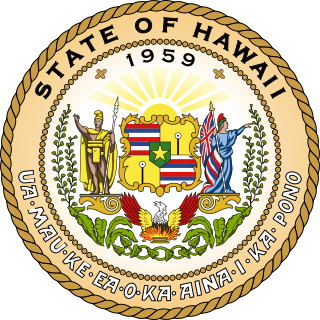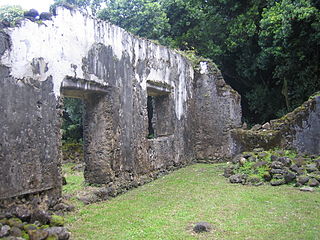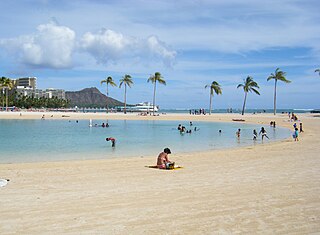
Moanalua is a valley, a stream, an ahupuaʻa, and a residential neighborhood in Honolulu, Hawaiʻi. The valley extends inland from behind Āliapaʻakai crater (Salt Lake) to the crest of the Koʻolau Range.

Honolulu is the capital and largest city of the U.S. state of Hawaiʻi. It is an unincorporated part of and the county seat of the City and County of Honolulu along the southeast coast of the island of Oʻahu. The city is the main gateway to Hawaiʻi and a major portal into the United States. The city is also a major hub for international business, military defense, as well as famously being host to a diverse variety of east-west and Pacific culture, cuisine, and traditions.

Hawaii is the 50th and most recent state to have joined the United States, having received statehood on August 21, 1959. Hawaii is the only U.S. state located in Oceania, the only U.S. state located outside North America, and the only one composed entirely of islands. It is the northernmost island group in Polynesia, occupying most of an archipelago in the central Pacific Ocean.

Salt Lake is a neighborhood of Honolulu, Hawaii on the island of O‘ahu. The area is also known as Āliamanu after a nearby crater, although Salt Lake itself is in a crater called Ālia pa‘akai — meaning "salt pond" in the Hawaiian language. The Salt Lake community was developed in the 1960s during a construction boom, providing residents with an expansive view of downtown Honolulu and the sugarcane plantations of the central plain of O‘ahu. It is a community of high-rise condominiums, mid-rise town-dwellings, and houses snaking around the remnants of a now freshwater lake.
Contents
Neighboring areas include Māpunapuna and Salt Lake on the south, Fort Shafter on the east, and Red Hill and Hālawa Valley on the west.

Fort Shafter is in Honolulu CDP, City and County of Honolulu, Hawai‘i, extending up the interfluve (ridgeline) between Kalihi and Moanalua valleys, as well as onto the coastal plain at Māpunapuna. Fort Shafter is the headquarters of the United States Army Pacific, commanding most Army forces in the Asia-Pacific region with the exception of Korea. A portion of the area is also known as the Palm Circle Historic District and is listed on the National Register of Historic Places, and has been further designated as a U.S. National Historic Landmark. It is also known as Palm Circle or 100 Area. Palm Circle covers an underground command center.

Halawa is a census-designated place (CDP) in the ‘Ewa District of Honolulu County, Hawaii, United States. Halawa Stream branches into two valleys: North and South Halawa; North Halawa is the larger stream and fluvial feature. Their confluence is within the H-3/H-201 highways exchange. Most of Halawa Valley is undeveloped. As of the 2010 Census, the CDP had a population of 14,014.
Moanalua is a part of the 15th District of the Hawaii Senate, currently represented by State Senator Glenn Wakai. It is also a part of the 32nd District of the Hawaii House of Representatives, currently represented by Linda Ichiyama.

The Hawaii Senate is the upper house of the Hawaii State Legislature. It consists of twenty-five members elected from an equal number of constituent districts across the islands and is led by the President of the Senate, elected from the membership of the body, currently Ron Kouchi. The forerunner of the HawaiiSenate during the government of the Kingdom of Hawaii was the House of Nobles originated in 1840. In 1894 the Constitution of the Republic of Hawaii renamed the upper house the present senate. Senators are elected to four-year terms and are not subject to term limits.

The Hawaii House of Representatives is the lower house of the Hawaii State Legislature. Pursuant to Article III, Section 3 of the Constitution of Hawaii, amended during the 1978 constitutional convention, the House of Representatives consists of 51 members representing an equal number of districts across the islands. It is led by the Speaker of the House elected from the membership of the House, with majority and minority leaders elected from their party's respective caucuses. The current Speaker of the House is Scott Saiki.

Linda Ichiyama is a Democratic member of the Hawaii State House of Representatives, representing Moanalua, Aliamanu and Salt Lake, Hawaii in the 32nd District since 2013. Prior to this, Representative Ichiyama represented the same area when it was known as the 31st District since 2010.




















